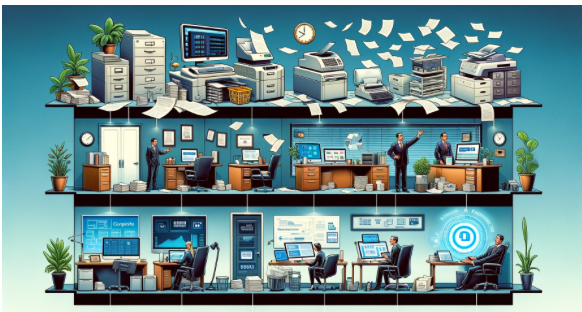To mark our business law firm’s 20th anniversary, I’ll be sharing a bi-monthly series of articles highlighting lessons learned over the past two decades. By transparently reflecting on our journey embracing change and innovation, I hope to provide perspective applicable beyond the legal industry. Thanks, Scott Levine.
The Cutting Edge of Yesterday
It’s remarkable now to think about how groundbreaking simple technology like email and fax machines seemed when our firm first launched 20 years ago. I distinctly remember the excitement when our first multifunction fax/printer/copier arrived in the early 2000s. That clunky machine felt like the height of workplace tech efficiency at the time.
Of course, in just twenty short years, that once-cutting edge device seems downright ancient compared to the lightning pace of innovation since. The evolution of legal technology we’ve witnessed firsthand over the past two decades has been simply staggering.
Introducing Basic Digital Systems
In the beginning, just integrating basic digital tools like an electronic calendar system, shared contacts database, and email capability felt like major milestones for firm-wide coordination. Replacing antiquated standalone processes with centralized systems took our once heavily paper-driven workflows into the digital age.
I recall the panic when our email server unexpectedly crashed early on, paralyzing operations for a day. It vividly underscored our quickly growing reliance on technology we now take for granted. Even tasks like scheduling or sharing documents became infinitely more efficient.
The Road to a Paperless Office
A pivotal milestone was achieving our goal of going completely paperless around 10 years ago. By fully digitizing client files and implementing standardized naming conventions, we streamlined collaboration exponentially. Attorneys could now access the exact documents needed from anywhere, anytime – a flexibility that strengthened client service.
This digital transformation also minimized physical storage needs and messy filing backlogs. But the benefits went well beyond efficiency. Taking a forward-thinking, environmentally-conscious step like “going green” reflected our firm values.
New Innovations, New Challenges
Of course, new innovations meant new support demands. As technology evolved, we contended with constant training and change management needs to ensure successful adoption. Early on, we learned the hard way that simply purchasing the latest tools was futile without properly onboarding people.
Although video conferencing and cloud-based portals theoretically boosted efficiency, poor execution stifled results. Attorneys struggled to utilize unfamiliar programs dumped on them without context. It took time to find the right balance between experimenting with technology and strategic implementation.
Smooth Sailing with Microsoft Teams
With Microsoft Teams, we took a more measured approach. Through training and pilot groups before firmwide rollout, we supported people in becoming truly comfortable with the software. The result was our distributed team could seamlessly communicate and collaborate, message, meet, and share files easily.
This thoughtful implementation proved pivotal in facilitating coordination, cohesiveness and productivity – even as we rapidly expanded. It demonstrated how change management should complement technological advancement.
The Research Game Changer
And of course, no technology has transformed how legal work gets done more profoundly than powerful research databases like Westlaw and LexisNexis. Practically overnight, instant digital access to case law and rulings replaced treks to dusty law libraries to dig through book stacks.
The enhanced reach allowed us to uncover precedents and build arguments with incredible speed and specificity. The difference between chasing down physical law journals versus keyword searching online feels like the Stone Age versus the Space Age.
Artificial Intelligence and the Future
Today, we stand on the cusp of the next technological sea change – the rapid emergence of artificial intelligence in the legal realm. Already AI is supercharging once manually intensive tasks like discovery and contract review by analyzing volumes of documents faster than humanly possible.
This means attorneys can devote focus to higher-level strategic analysis, allowing us to better counsel clients. AI unquestionably raises valid ethical considerations, but harnessed judiciously, it has immense potential to expand access and affordability.
Key Lessons Learned
Reflecting on the past 20 years of exponential change leaves us humbled – and hungry for what lies ahead. But embracing innovation has undoubtedly pushed our firm to new heights. Along the way, we gained several key insights:
-
Training and change management remain essential in new technology adoption
-
Balance willingness to experiment with strategic, purposeful implementation
-
Maintain laser focus on how new tools can enhance client service and culture
-
Foster constant innovation and improvement – don’t become complacent
-
Ensure cutting-edge technology complements human connection, not replaces it
The tools will continue advancing rapidly. But our mission and values are constant – anchored in service, ethics and empowering lives through legal expertise. The future looks bright, and we cannot wait to see what the next 20 years of legal technology may bring! If you’re an entrepreneur and would like to share experience, feel free to reach out to me by clicking here.




